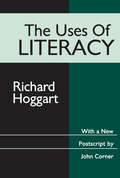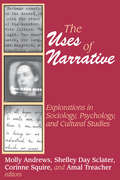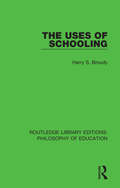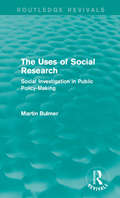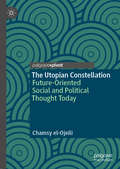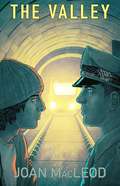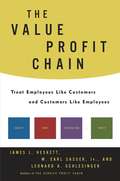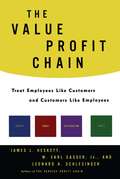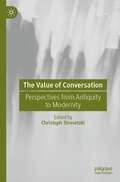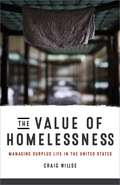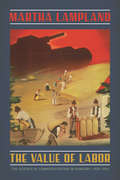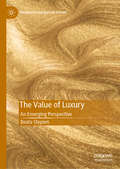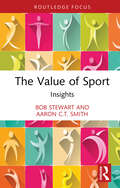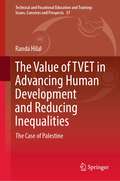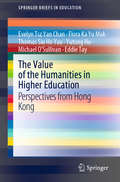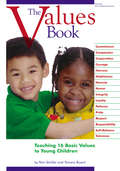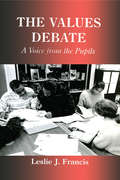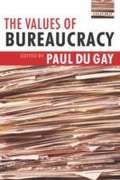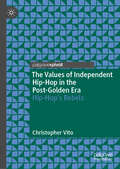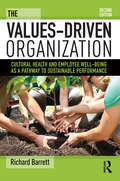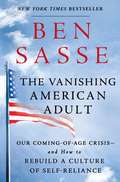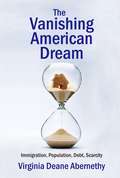- Table View
- List View
The Uses of Literacy: Aspects Of Working-lass Life (Classics In Communication And Mass Culture Ser.)
by Richard HoggartThis pioneering work examines changes in the life and values of the English working class in response to mass media. First published in 1957, it mapped out a new methodology in cultural studies based around interdisciplinarity and a concern with how texts-in this case, mass publications-are stitched into the patterns of lived experience. Mixing personal memoir with social history and cultural critique, The Uses of Literacy anticipates recent interest in modes of cultural analysis that refuse to hide the author behind the mask of objective social scientific technique. In its method and in its rich accumulation of the detail of working-class life, this volume remains useful and absorbing.Hoggart's analysis achieves much of its power through a careful delineation of the complexities of working-class attitudes and its sensitivity to the physical and environmental facts of working-class life. The people he portrays are neither the sentimentalized victims of a culture of deference nor neo-fascist hooligans. Hoggart sees beyond habits to what habits stand for and sees through statements to what the statements really mean. He thus detects the differing pressures of emotion behind idiomatic phrases and ritualistic observances.Through close observation and an emotional empathy deriving, in part, from his own working-class background, Hoggart defines a fairly homogeneous and representative group of working-class people. Against this background may be seen how the various appeals of mass publications and other artifacts of popular culture connect with traditional and commonly accepted attitudes, how they are altering those attitudes, and how they are meeting resistance. Hoggart argues that the appeals made by mass publicists-more insistent, effective, and pervasive than in the past-are moving toward the creation of an undifferentiated mass culture and that the remnants of an authentic urban culture are being destroyed.In his introduction to this new edition, Andrew Goodwin, professor of broadcast communications arts at San Francisco State University, defines Hoggart's place among contending schools of English cultural criticism and points out the prescience of his analysis for developments in England over the past thirty years. He notes as well the fruitful links to be made between Hoggart's method and findings and aspects of popular culture in the United States.
The Uses of Narrative: Explorations in Sociology, Psychology and Cultural Studies
by Shelley SclaterSocial scientists increasingly invoke "narrative" in their theory and research. This book explores the wide range of work in sociology, psychology and cultural studies in which narrative approaches have been used to study meaning, subjectivity, politics, and power in concrete contexts.The Uses of Narrative presents a range of case studies, including: Princess Diana's Panorama interview, media coverage of the 1992 Los Angeles riots, memoirs of the wives of scientists who made the first atomic bomb, popular images of gay marriage, and the effect of the "Velvet Revolution" on writing autobiography.The book brings together contributions from European, Australian, and North American researchers, indicating the diversity and potential of narrative approaches. The editors adopt a distinctive and unique psychosocial approach to narrative, and set the individual chapters in the context of three broad themes: culture, life histories, and discourse. The Uses of Narrative complicates, challenges and stimulates--it will be of vital interest to sociologists, psychologists, social theorists, students of cultural studies, and others who are interested in the relationships between meaning, self and society.
The Uses of Schooling (Routledge Library Editions: Philosophy of Education #5)
by Harry S. BroudyThe Uses of Schooling, first published in 1988, proposes a radically different approach to the evaluation of education. Professor Broudy shows that the common criteria of school effectiveness – that is the ability to replicate the end-of-course performance on examinations or to apply such results – clearly demonstrates the ‘uselessness’ of much of the investment made in schooling. This is so because, unless constantly reinforced by repetition the ability to replace test performance is rapidly diminished after formal school ends. This study will be of interest to students of education.
The Uses of Social Research: Social Investigation in Public Policy-Making (Routledge Revivals)
by Martin BulmerThe growth and health of the social sciences owe a good deal to the generally held belief that they are socially useful, but is this really so? Do they deliver the goods they promise? In The Uses of Social Research, first published in 1982, Martin Bulmer answers these and other questions concerning the uses of empirical social science in the policy-making process, and provides an extended analysis of the main issues. This title provides a valuable introduction to the patterns of influence exercised by the social sciences on government. It shows how the results of social research feed into the political system and what models of the relationship between research and policy are most convincing. This book will be of interest to students of the social sciences.
The Utopian Constellation: Future-Oriented Social and Political Thought Today
by Chamsy el-OjeiliThis book examines the utopian dimension of contemporary social and political thought. Arguing for a utopian optic for the human sciences, el-Ojeili claims that major transformations of the utopian constellation have occurred since the end of the twentieth century. Following a survey of major utopian shifts in the modern period, el-Ojeili focuses on three spaces within today’s utopian constellation. At the liberal centre, we see a splintering effect, particularly after the global financial crisis of 2008: a contingent neo-liberalism, a neo-Keynesian turn, and a liberalism of fear. At the far-Right margin, we see the consolidation of post-fascism, a combination of “the future in the past”, elements of the post-modern present, and appeals to a novel future. Finally, at the far-Left, a new communism has emerged, with novel positions on resistance, maps of power, and a contemporary variant of the Left’s artistic critique. The Utopian Constellation will be of interest to scholars and students across the human sciences with an interest in utopian studies, ideological and discourse analysis, the sociology of knowledge, and the study of political culture.
The Utopian Vision Of Charles Fourier; Selected Texts On Work, Love, And Passionate Attraction
by Charles FourierThe Utopian Vision Of Charles Fourier; Selected Texts On Work, Love, And Passionate Attraction by Charles Fourier
The Vagabond in the South Asian Imagination: Resilience, Agency and Representation
by Avishek RayThis book discusses the epistemic foundation of the heuristic construct ‘vagabond’ and the convergence between the politics of itinerancy and that of dissent in the context of South Asia. It describes the fraught relationship between ‘native’ itinerant practices and techniques of governmentality which have furnished different categorizations and taxonomies of mobility. The book demonstrates the historical seismic breaks – from the Orientalist to the post-Orientalist, from the premodern to the modern, and from the colonial to the post-colonial – in the representation of the vagabond in the juridico-political imagination, in historiography and cultural articulation. For instance, the drunk European sailor, the quasi-religious mendicant, and the helpless famine refugee have all been referred to as ‘vagabonds’ in the colonial archive. This book examines the histories and conditions behind these conceptual overlaps, as well as the uncanny associations among categories that uneasily coexist and mirror each other as subsets of a vast range of phenomena, which may loosely be called ‘vagabond(age)’. This volume will be of interest to students and researchers of literature, cultural studies, colonial and post-colonial studies, history, migration studies, sociology, and South Asia studies.
The Valley
by Joan Macleod"MacLeod has a wonderful ear and eye for the everyday details."--Calgary HeraldInspired by the 2007 Tasering death of Robert Dziekanski at the Vancouver airport, The Valley dramatizes the volatile relationship between law enforcement and people in the grip of mental illness. The play connects both sides of this relationship by portraying two families embattled with depression, each guided by good intentions but challenged by their own flawed humanity.Joan MacLeod is the author of numerous award-winning plays. Her work has been translated into more than eight languages with productions throughout the world, including a sold-out run in New York.
The Value Profit Chain
by James L. HeskettJames Heskett, Earl Sasser, and Leonard Schlesinger reveal powerful new evidence that paying close attention to the employee-customer relationship will enableanyorganization to be a low-cost providerandachieve superior results -- proving that you can have it all, a goal thought inadvisable just a few short years ago. At the heart of this bold assertion is the authors' indisputable conclusion supported by thirty-one years of groundbreaking research:today's employee satisfaction, loyalty, and commitment strongly influences tomorrow's customer satisfaction, loyalty, and commitment and ultimately the organization's profit and growth-- a quantifiable set of associations the authors call the value profit chain. In what may be the most far-reaching study ever undertaken of the strategic importance of the employee-customer relationship, Heskett, Sasser, and Schlesinger offer profound new insights into the life-long value of both employees and customers and the increasingly important concept of employee-relationship management. Readers will discover how organizations as diverse as aluminum maker Alcoa, travel agency Rosenbluth International, and the Willow Creek Community Church treat employees like customers (in the case of Willow Creek, volunteers as well). Conversely, the authors show how advertising agency Merkley Newman Harty and financial services provider ING Direct treat customers like employees, pursuing the ones they want most. At the Vanguard Group, Cisco Systems, and Southwest Airlines, both practices are common. The authors explain how these organizations and many others -- whether large or small, public or private, or not-for-profit -- achieve profitability and growth or the equivalent by leveraging results and process quality to deliver differentiated products and services at the lowest cost. Timely, essential, and important reading,The Value Profit Chainshould be readily accessible on the desk of every forward-thinking manager.
The Value Profit Chain
by James L. Heskett W. Earl Sasser Leonard A. SchlesingerJames Heskett, Earl Sasser, and Leonard Schlesinger reveal powerful new evidence that paying close attention to the employee-customer relationship will enable any organization to be a low-cost provider and achieve superior results -- proving that you can have it all, a goal thought inadvisable just a few short years ago. At the heart of this bold assertion is the authors' indisputable conclusion supported by thirty-one years of groundbreaking research: today's employee satisfaction, loyalty, and commitment strongly influences tomorrow's customer satisfaction, loyalty, and commitment and ultimately the organization's profit and growth -- a quantifiable set of associations the authors call the value profit chain. In what may be the most far-reaching study ever undertaken of the strategic importance of the employee-customer relationship, Heskett, Sasser, and Schlesinger offer profound new insights into the life-long value of both employees and customers and the increasingly important concept of employee-relationship management. Readers will discover how organizations as diverse as aluminum maker Alcoa, travel agency Rosenbluth International, and the Willow Creek Community Church treat employees like customers (in the case of Willow Creek, volunteers as well). Conversely, the authors show how advertising agency Merkley Newman Harty and financial services provider ING Direct treat customers like employees, pursuing the ones they want most. At the Vanguard Group, Cisco Systems, and Southwest Airlines, both practices are common. The authors explain how these organizations and many others -- whether large or small, public or private, or not-for-profit -- achieve profitability and growth or the equivalent by leveraging results and process quality to deliver differentiated products and services at the lowest cost. Timely, essential, and important reading, The Value Profit Chain should be readily accessible on the desk of every forward-thinking manager.
The Value of Conversation: Perspectives from Antiquity to Modernity
by Christoph StrosetzkiWhat is the value of conversation measured by? Are there more valuable and inferior types of conversation? What role do the contents, the people, and the circumstances play? Do times and epochs shape their own conversations? Conversation norms from handbooks as well as conversations reproduced in texts or reconstructed from texts shed light on these questions. The contributions in this volume are grouped around conceptual questions, specific contexts such as the salon and the table conversation, bring studies on individual literary texts and cover the European cultural history from Plato to the 20th century.
The Value of Homelessness: Managing Surplus Life in the United States (Difference Incorporated)
by Craig WillseIt is all too easy to assume that social service programs respond to homelessness, seeking to prevent and understand it. The Value of Homelessness, however, argues that homelessness today is an effect of social services and sciences, which shape not only what counts as such but what will?or ultimately won&’t?be done about it. Through a history of U.S. housing insecurity from the 1930s to the present, Craig Willse traces the emergence and consolidation of a homeless services industry. How to most efficiently allocate resources to control ongoing insecurity has become the goal, he shows, rather than how to eradicate the social, economic, and political bases of housing needs. Drawing on his own years of work in homeless advocacy and activist settings, as well as interviews conducted with program managers, counselors, and staff at homeless services organizations in New York, Los Angeles, San Francisco, and Seattle, Willse provides the first analysis of how housing insecurity becomes organized as a governable social problem.An unprecedented and powerful historical account of the development of contemporary ideas about homelessness and how to manage homelessness, The Value of Homelessness offers new ways for students and scholars of social work, urban inequality, racial capitalism, and political theory to comprehend the central role of homelessness in governance and economy today.
The Value of Labor: The Science of Commodification in Hungary, 1920-1956
by Martha LamplandAt the heart of today's fierce political anger over income inequality is a feature of capitalism that Karl Marx famously obsessed over: the commodification of labor. Most of us think wage-labor economics is at odds with socialist thinking, but as Martha Lampland explains in this fascinating look at twentieth-century Hungary, there have been moments when such economics actually flourished under socialist regimes. Exploring the region's transition from a capitalist to a socialist system--and the economic science and practices that endured it--she sheds new light on the two most polarized ideologies of modern history. Lampland trains her eye on the scientific claims of modern economic modeling, using Hungary's unique vantage point to show how theories, policies, and techniques for commodifying agrarian labor that were born in the capitalist era were adopted by the socialist regime as a scientifically designed wage system on cooperative farms. Paying attention to the specific historical circumstances of Hungary, she explores the ways economists and the abstract notions they traffic in can both shape and be shaped by local conditions, and she compellingly shows how labor can be commodified in the absence of a labor market. The result is a unique account of economic thought that unveils hidden but necessary continuities running through the turbulent twentieth century.
The Value of Luxury: An Emerging Perspective (Palgrave Advances in Luxury)
by Beata StępieńWhat does luxury value mean? What constitutes luxury, and what does not? While previous research has focused on luxury as a global business and how companies have generated, communicated and monetized luxury, this book draws on empirical research to examine how consumers understand and interact with it. It identifies the components of luxury value, as seen by consumers, and the most influential factors that shape these perceptions. Drawing on a range of disciplinary approaches, the author investigates how consumer segments differ in their perception of luxury products, and how different generations understand value. A comprehensive overview of consumer perceptions of luxury, this book is a must-read for those students and researchers interested in luxury studies.
The Value of Sport: Insights (Sport Business Insights)
by Bob Stewart Aaron C.T. SmithThis concise and thought-provoking book examines the myths and realities surrounding the value of sport. It asks a fundamental question: what is it about sport that leads to grand claims about its supposed capacity to do so many good things for society?Examining the evidence from sport around the world, at all levels, the book challenges the commonly held, uncritical assumptions about the value of sport. It looks closely at the claims that sport is likely to improve physical and mental health and social cohesion or that there are demonstrable economic benefits to local communities and positive legacy effects from international sporting events and elite athletic successes. Adopting a value-adding perspective, the book argues that governments and policy-makers must strip away the myths, be more critical in their thinking, and recognise the counter-argument that sport is also associated with negative effects, whether that’s the opportunity costs of allocating public funds to sport or the social harms for which sport can be responsible, such as drug use, violence, misogyny, racism, injury, or abuse. The book presents a broad-based framework for assessing the value of sport that focuses on citizen well-being, where a mix of collaborative public and self-organised regulation is used to help sport avoid becoming an infamous case study in market failure.Presenting fresh thinking on an important topic, this book is essential reading for anybody working in sport policy, sport governance, sport management, or wider public policy spaces.
The Value of TVET in Advancing Human Development and Reducing Inequalities: The Case of Palestine (Technical and Vocational Education and Training: Issues, Concerns and Prospects #37)
by Randa HilalThis book examines the contribution of Vocational Education and Training to advancing human development and reducing inequality. It uses the example of Palestine as case-study rich in multi-layered inequalities, some of which are experienced in the region and worldwide, while others are specific to adverse conditions. The case of Palestine provides fertile ground for understanding inequality and human development, and for echoing the developed knowledge through to the understanding of Vocational Education and Training and Human Development globally. The book brings original theoretical approaches, evidence of the value of Vocational Education and Training, and contributes to academic debates, as well as provides empirical evidence for practitioners and donor community.
The Value of the Humanities in Higher Education: Perspectives from Hong Kong (SpringerBriefs in Education)
by Eddie Tay Michael O'Sullivan Evelyn Tsz Chan Flora Ka Mak Thomas Siu Yau Yutong HuThis book presents an extensive analysis of the multifaceted benefits that higher education in the humanities offers individuals and society, as explored in the context of Hong Kong. Using both quantitative graduate employment survey data and qualitative data from interviews with past humanities graduates and with leading humanities scholars, the study provides an objective picture of the “value” of humanities degrees in relation to the economic needs and growth of Hong Kong, together with an in-depth exploration of their value and use in the eyes of humanities graduates and practitioners. Therefore, although it is hardly the only book on the value and status quo of the humanities worldwide, it nonetheless stands out in this crowded field as one of the very few extended studies that draws on empirical data.The book will appeal to both an academic and a wider audience, including members of the general public, non-academic educators, and government administrators interested in the status quo of humanities education, whether in Hong Kong or elsewhere. The report also includes a wealth of text taken directly from interviews with humanities graduates, who share their compelling life stories and views on the value of their humanities education.
The Values Book: Teaching 16 Basic Values to Young Children
by Pam Schiller Tamera BryantYoung children learn best by doing, and that includes learning values. The Values Book is packed with easy activities, projects and ideas to help children learn values and build character, both individually and in groups. Each chapter addresses one of 16 different values, including understanding, patience and tolerance. After defining the value, each chapter begins with questions to help adults clarify what that value means to them. The perfect book to introduce and strengthen the teaching of values in any early childhood classroom or home.
The Values Debate: A Voice from the Pupils (Woburn Education Series)
by Leslie J. FrancisPresents findings from a survey conducted among 30,000 13-15 year olds throughout England and Wales, giving particular attention to social, personal and moral issues.
The Values of Bureaucracy
by Paul Du GayFrom the introduction: "The demise of bureaucracy has been anticipated, and demanded, many times throughout the history of management thought, as well as in modern social and political theory. However, despite the scorn regularly heaped upon it, bureaucracy, both as an organizational ideal and as a diversely formatted organizational device, has proven remarkably resilient. Reports of its death have turned out to be somewhat premature. Despite the dramatic claims of certain prominent contemporary management gurus and social theorists that the end of the bureau is once again nigh (Castells 2000; Giddens 1998; Heckscher and Donnellon 1994; Leadbeater 1999; Peters 1989), there remain plenty of reasons to be cautious."
The Values of Independent Hip-Hop in the Post-Golden Era: Hip-Hop’s Rebels
by Christopher VitoUtilizing a mixed-methods approach, this book uncovers the historical trajectory of U.S. independent hip-hop in the post-golden era, seeking to understand its complex relationship to mainstream hip-hop culture and U.S. culture more generally. Christopher Vito analyzes the lyrics of indie hip-hop albums from 2000-2013 to uncover the dominant ideologies of independent artists regarding race, class, gender, sexual orientation, and social change. These analyses inform interviews with members of the indie hip-hop community to explore the meanings that they associate with the culture today, how technological and media changes impact the boundaries between independent and major, and whether and how this shapes their engagement with oppositional consciousness. Ultimately, this book aims to understand the complex and contradictory cultural politics of independent hip-hop in the contemporary age.
The Values-Driven Organization: Cultural Health and Employee Well-Being as a Pathway to Sustainable Performance
by Richard BarrettValues-driven organizations are the most successful organizations on the planet. This book explains that understanding employees’ needs—what people value—is the key to creating a high performing organization. When you support employees in satisfying their needs, they respond with high levels of engagement and willingly commit their energies to the organization, bringing passion and creativity to their work. This new edition of The Values-Driven Organization provides an updated set of tools to assess corporate culture, new case studies on cultural transformation and additional materials on sustainability, measuring cultural health at work and the specific needs of the millennial generation. The Values-Driven Organization is essential reading for students, researchers and practitioners of organizational change, leadership, HRM and business ethics.
The Values-Driven Organization: Unleashing Human Potential for Performance and Profit
by Richard BarrettBased on significant new research from multiple sources, Richard Barrett creates a compelling narrative about why values-driven organizations are the most successful organizations on the planet. According to Barrett, understanding employee's needs--what people value--is the key to creating a high performing organization. When you support employees in satisfying their needs, they respond with high levels of employee engagement and willingly bring their commitment and creativity to their work. This book updates and brings together in one volume, two of Richard Barrett's previous publications, Liberating the Corporate Soul (1998) and Building a Values-Driven Organisation (2006), to provide a reference manual for leaders and change agents who wish to create a values-driven organization. The text provides both a leadership approach, and a language, for organizational transformation and culture change that incorporates concepts such as cultural entropy, values alignment and whole system change. With an updated set of cultural diagnostic tools and a wide range of new and exciting case studies on culture and leadership development, The Values-Driven Organization will be essential reading for students, researchers and practitioners in the fields of organizational change, leadership and ethics.
The Vanishing American Adult: Our Coming-of-Age Crisis--and How to Rebuild a Culture of Self-Reliance
by Ben Sasse<P>In an era of safe spaces, trigger warnings, and an unprecedented election, the country's youth are in crisis. Senator Ben Sasse warns the nation about the existential threat to America's future. <P>Raised by well-meaning but overprotective parents and coddled by well-meaning but misbegotten government programs, America's youth are ill-equipped to survive in our highly-competitive global economy. Many of the coming-of-age rituals that have defined the American experience since the Founding: learning the value of working with your hands, leaving home to start a family, becoming economically self-reliant—are being delayed or skipped altogether. <P>The statistics are daunting: 30% of college students drop out after the first year, and only 4 in 10 graduate. One in three 18-to-34 year-olds live with their parents. From these disparate phenomena: Nebraska Senator Ben Sasse who as president of a Midwestern college observed the trials of this generation up close, sees an existential threat to the American way of life. <P>In The Vanishing American Adult, Sasse diagnoses the causes of a generation that can't grow up and offers a path for raising children to become active and engaged citizens. He identifies core formative experiences that all young people should pursue: hard work to appreciate the benefits of labor, travel to understand deprivation and want, the power of reading, the importance of nurturing your body—and explains how parents can encourage them. <P>Our democracy depends on responsible, contributing adults to function properly—without them America falls prey to populist demagogues. A call to arms, The Vanishing American Adult will ignite a much-needed debate about the link between the way we're raising our children and the future of our country. <P><b>A New York Times Bestseller</b>
The Vanishing American Dream: Immigration, Population, Debt, Scarcity
by Virginia Deane AbernethyThe United States has gone off track, allowing domestic and foreign aid policies to be co-opted by a government—abetted by mass media—that serves special interests rather than the greater national good. Americans' tendencies to trust, play fair, and help have been abused and require replacement by a realistic outlook.The Vanishing American Dream posits solutions to get America back on the right track. Abernethy sees population growth driven by mass immigration as a major cause of economic and cultural changes that have been detrimental to most Americans. The environment has been degraded by over-crowding and increasing demands on natural resources. Work is cheapened by explosive growth in the labour force creating a buyer's market. One salary or wage no longer supports a family and educates children. Women working outside the home is a necessity, not a choice, for most American families. Furthermore, feminism, aimed originally at balanced gender roles, has been turned viciously against males of all ages and ultimately against females through degrading their traditional and valuable contributions.Abernethy proposes that Americans need time to regroup, untroubled by a continuing influx of foreign peoples. The family, small business, and responsive local government are centres around which a solvent and confident citizenry can prosper again.
